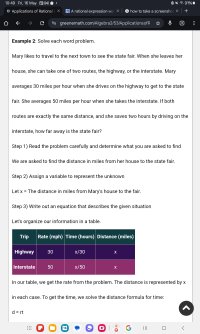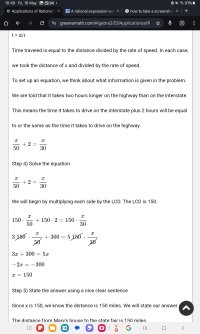I know this is an old post, but I believe it represents an important pedagogical point.
I believe we should teach beginning students of elementary algebra to assign a unique symbol to each unknown quantity, and then say we need as many equations as we have symbols to find a solution.
[math]\text {distance in miles to state fair } = d,\\
\text {hours to make trip on interstate } = x, \text { and}\\
\text {hours to make trip on highway } = y.\\
x = \dfrac{d}{50}.\\
y = \dfrac{d}{30}.\\
x = y - 2 \text { or } y = x + 2.
[/math]
Tracking the language of the word problem a la Dr. Peterson is good because it is highly intuitive even though formally irrelevant.
Now this approach demands that we teach a little formal algebra before actually trying to SOLVE word problems.
Substitution
[math]x = \dfrac{d}{50} \implies y - 2 = \dfrac{d}{50}.[/math]
Clearing fractions.
[math]y - 2 = \dfrac{d}{50} \implies 50(y - 2) = 50 \times \dfrac{d}{50} \implies 50y - 100.= d.\\
y = \dfrac{d}{30} \implies 30y = 30 \times \dfrac{d}{30} = d.[/math]
Creating equations for known equalities.
[math]30y = d \text { and } 50y - 100 = d \implies 30y = 50y - 100 \implies\\
30y - 30y = 50y - 30y - 100 \implies 0 = 20y - 100 \implies \\
0 + 100 = 20y - 100 + 100 \implies 100 = 20y \implies 20y = 100 \implies\\
\dfrac{20y}{20} = \dfrac{100}{20} \implies y = 5.[/math]
But then it is obvious that
[math] x = y - 2 = 5 - 2 = 3 \text { and }\\
3 = \dfrac{d}{50} \implies 50 \times 3 = 50 \times \dfrac{d}{50} \implies 150 = d.\\
\text {CHECK:} \dfrac{150}{50}= 3 = x \text { as found before.}[/math]
I admit we do not teach algebra this way. I merely claim that we should, and if we did, this student would not have been confused by this problem.


